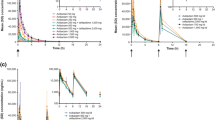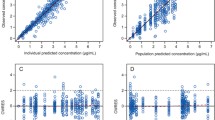Abstract
A simplified dosing algorithm for trovafloxacin was evaluated following a single-dose infusion of alatrofloxacin at trovafloxacin equivalent doses of 30, 100, 200, 300 and 400 mg (57 subjects), and multiple doses of 200, 300 and 400 mg (30 subjects). Maximum serum concentration and area under the concentration-time curve for trovafloxacin increased with dose. Trovafloxacin clearance (82–85 ml · h/kg) and volume of distribution (1.3–1.6 l/kg) were independent of dose. Infusion of alatrofloxacin at a trovafloxacin equivalent dose of 300 mg at 1, 2 or 3 mg/ml over 1 h did not alter the pharmacokinetics of trovafloxacin. A plot of the weight-adjusted dose of trovafloxacin in individual subjects against the maximum serum concentration following single and multiple dosing, indicated that the maximum serum concentration increased 1 μg/ml for each 1 mg/kg of trovafloxacin administered. Thus, a prior knowledge of the desired serum concentration will permit appropriate dosing without the use of complex nomograms in patients with normal hepatic function.
Similar content being viewed by others
References
Neu HC, Chin N-X: In vitro activity of the new fluoroquinolone CP-99,219. Antimicrobial Agents and Chemotherapy (1994) 38:2615–2622
Briggs-Gooding B, Jones RN: In vitro antimicrobial activity of CP-99,219, a novel azabicyclonaphthyridone. Antimicrobial Agents and Chemotherapy (1993) 37:349–353
Klugman KP, Wasas AJ: In-vitro activity of the fluoroquinolone trovafloxacin against penicillin-susceptible and-resistantStreptococcus pneumoniae. Journal of Antimicrobial Chemotherapy (1995) 36:873–874
Felmingham D, Robbins MJ, Ingley K, Mathias I, Bhogal H, Leakey A, Ridgway GL, Grüneberg RN: In-vitro activity of trovafloxacin, a new fluoroquinolone, against recent clinical isolates. Journal of Antimicrobial Chemotherapy (1997) 39, Supplement B:43–49
Child J, Andrews J, Boswell F, Brenwald N, Wise R: The in-vitro activity of CP-99,219, a new naphthyridone antimicrobial agent: a comparison with fluoroquinolone agents. Journal of Antimicrobial Chemotherapy (1995) 35:869–876
Endtz HP, Mouton JW, Den Hollander JG, Van den Braak N, Verbrugh HA: Comparative in vitro activities of trovafloxacin (CP-99,219) against 445 gram-positive isolates from patients with endocarditis and those with other bloodstream infections. Antimicrobial Agents and Chemotherapy (1997) 41:1146–1149
Gootz TD, Brighty KE, Anderson MR, Schmieder BJ, Haskell SL, Sutcliffe JA, Castaldi MJ, McGuirk PR: In vitro activity of CP-99,219, a novel 7-(3-azabicyclo [3.1.0] hexyl)-naphthyridone antimicrobial. Diagnostic Microbiology and Infectious Disease (1994) 19:235–243
Teng R, Harris SC, Nix DE, Schentag JJ, Foulds G, Liston TE: Pharmacokinetics and safety of trovafloxacin (CP-99,219), a new quinolone antibiotic, following administration of single oral doses to healthy male volunteers. Journal of Antimicrobial Chemotherapy (1995) 36:385–394
Girard AE, Girard D, Gootz TD, Faiella JA, Cimochowski CR: In vivo efficacy of trovafloxacin (CP-99,219), a new quinolone with extended activities against gram-positive pathogens,Streptococcus pneumoniae, andBacteroides fragilis. Antimicrobial Agents and Chemotherapy (1995) 39:2210–2216
Vincent J, Venitz J, Teng R, Baris BA, Willavize SA, Polzer RJ, Friedmen HL: Pharmacokinetics and safety of trovafloxacin in healthy male volunteers following administration of single intravenous doses of the prodrug, alatrofloxacin. Journal of Antimicrobial Chemotherapy (1997) 39, Supplement B:75–80
Teng R, Tensfeldt TG, Liston TE, Foulds G: Determination of trovafloxacin, a new quinolone antibiotic, in biological samples by reverse-phase high-performance liquid chromatography. Journal of Chromatography (1996) 675:53–59
Karabalut N, Drusano GL: Pharmacokinetics of the quinolone antimicrobial agents. In: Hooper DC, Wolfson JS (eds): Quinolone Antimicrobial Agents. American Society for Microbiology, Washington, DC (1993), pp. 195–223
Tsubakihara Y, Itoh T, Kitamura E, Okada N, Nakanishi I, Iida N: Pharmacokinetics of ofloxacin in patients with severe chronic renal failure. Reviews of Infectious Diseases (1989) 11, Supplement 5:1006–1007
Stuck AE, Frey FJ, Heizmann R, Brandt R, Weidekamm E: Pharmacokinetics and metabolism of intravenous and oral fleroxacin in subjects with normal and impaired renal function and in patients on continuous ambulatory peritoneal dialysis. Antimicrobial Agents and Chemotherapy (1989) 33:373–381
Author information
Authors and Affiliations
Rights and permissions
About this article
Cite this article
Vincent, J., Dogolo, L., Baris, B.A. et al. Single- and multiple-dose administration, dosing regimens, and pharmacokinetics of trovafloxacin and alatrofloxacin in humans. Eur. J. Clin. Microbiol. Infect. Dis. 17, 427–430 (1998). https://doi.org/10.1007/BF01691577
Issue Date:
DOI: https://doi.org/10.1007/BF01691577




